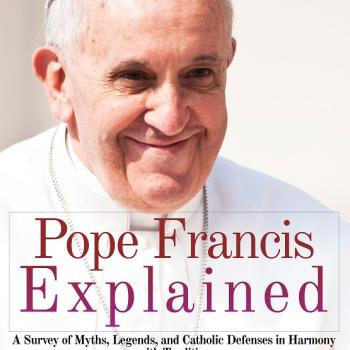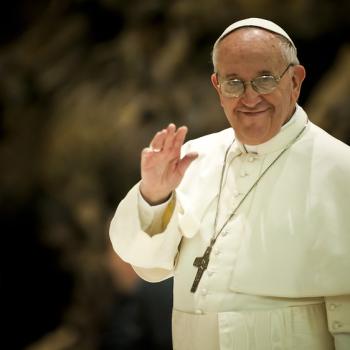
Luke 11:42 (RSV) “But woe to you Pharisees! for you tithe mint and rue and every herb, and neglect justice and the love of God; these you ought to have done, without neglecting the others.”
Matthew 23:24 “You blind guides, straining out a gnat and swallowing a camel!”
The latest tempest-in-a-teapot with regard to opposition to Pope Francis had to do with whether he wants people to kiss his ring or not. All the usual radical Catholic reactionary suspects came out for this one and made complete asses of themselves. But first, let’s see how Reuters: a relatively neutral secular news outlet, reported the incident:
The mystery of why Pope Francis repeatedly withdrew his right hand as a long line of people bowed and tried to kiss it this week has been resolved – he did not want to spread germs.
“It was a simple question of hygiene,” Vatican spokesman Alessandro Gisotti told reporters on Thursday after he asked the pope directly.
Gisotti explained that there were many people in line and the pope did want to spread germs as one person after another repeatedly kissed his hand at short intervals.*Monday’s footage went viral on social media and was featured on late-night comedy shows in the United States.
The pope’s refusal quickly entered what are known as the Catholic cultural wars between conservatives and progressives.*
One conservative Catholic website that often criticizes the pope called the episode “disturbing” and another said the pope should resign if he did not like rituals.
It would seem to be a simple enough thing, wouldn’t it? There was a silly ruckus, and at length the pope explained it. End of story; it’s a non-incident. It’s okay to be concerned about hygiene. That’s an act of love. But not for the radical Catholic reactionaries, who seize every opportunity imaginable to run down this pope. So here are two typical examples of their pitiable rhetoric and scandalous, slanderous polemics, from two of the most influential reactionary sites:
[title] Francis, If you don’t want to be the Vicar of Christ, then get out of there!
These people are not kissing Jorge Mario Bergoglio, it is not all about him, and his person, as he seems to think.
They want to kiss Peter, the Vicar of Christ. It’s monstrous to deny them that. (Rorate Caeli, 3-26-19)*[title] Is Francis Losing His Mind? (Bizarre Behavior Rattles Catholic Faithful)
. . . This is Francis insulting visiting faithful, merely for trying to follow protocol and honor the august office of the papacy. (Note to Francis: It’s not about you, Holiness!)
It suggests either severe anger management issues or a kind of out-of-control narcissism that manifests itself in borderline sociopathic behavior. And at the very least, it indicates a loathing for the office of the papacy such as the Church has never before witnessed in an occupant of the Chair of St. Peter.
It’s as if it actually infuriates him when the faithful fail to duly appreciate the systematic degradation of the papacy on which he’s been working since he first appeared on the loggia and asked us to bless him.
God help us, what is wrong with this man? (Michael J. Matt, The Remnant, 3-25-19)
It’s much ado about nothing, as usual. Whoever has made an issue of this ought to be ashamed of themselves. But we’re long past shame for many, when it comes to the Holy Father. All the time (with a few exceptions on occasion) we hear stuff as stupid and clueless as what anti-Catholics toss out about Catholicism.
A tour guide (“the catholictraveler”) provided some very helpful information on 3-27-19:
Lots of drama about the video of Pope Francis not letting people kiss his ring the other day in Loreto.
I’ve kissed the ring of Pope Francis twice. Pope Benedict three times. Pope John Paul II once.
When I met Pope John Paul II in 2003 with my wife and about 50 other people, we were briefed ahead of time and told not to kiss the ring or kneel. . . .
Each time I met Popes Benedict and Francis, the occasion was much less formal, so no instructions were given and lots of people knelt and kissed the ring.
There are many situations where people meet and greet the Holy Father. Sometimes due to time/health/safety or even reasons we don’t know, people may receive specific instructions, like don’t kiss the ring.
We might think we are being pious or traditional or respecting the office, but really we are being rude and not following instructions.
I don’t know if the people in Loreto were instructed to not kiss the ring, but I’ve been to enough Papal events (hundreds) to know that some people don’t know how to act when in the presence of a pope — or any celebrity.
David Gibson, director of Fordham’s Center on Religion and Culture, tweeted on 3-25-19: “John Paul II and Benedict XVI frequently did the same thing, raising petitioners up rather than letting them kiss the ring.”
I found an excerpt about Pope Benedict XVI and ring-kissing in a book written by Augustine Roberts, OCSO (b. 1932), who was Procurator General of the Trappist Order. He met Pope Benedict on one occasion at St. Peter’s, and reports that:
He tried to keep me from kissing his ring and immediately clasped my hands between both of his, gently but firmly. (Finding The Treasure: Letters from a Global Monk, Cistercian Publications / Liturgical Press [Collegeville, Minnesota], 2011, p. 229)
I found another anecdote about Pope Gregory XVI (r. 1831-1846), in a book written by Bishop Martin Spalding (1810-1872), about Bishop Joseph Flaget (1763-1850): both of Lousville. This is how Bishop Flaget described his meeting the pope (who deliberately prevented him from kissing his ring):
Following the usual ceremonial, I made the three prostrations, and at the third I kissed with affection the cross embroidered on his sandal: . . . According to the ceremonial, I should have remained kneeling until the Pope would give me a sign to rise; but in this audience, altogether friendly and paternal, there was no ceremony to be observed. The excellent Pontiff bowed down, seized me in both arms, and as I was preparing to kiss his ring, he pressed me to his bosom, and embraced me tenderly, saluting me affectionately on both cheeks.
Such was the impression which these marks of friendship made on my heart, that it was impossible for me to articulate a single word, and I thought I was going to be ill. At this sight the Pope was moved, he pressed me again on his breast, and, with a tender embrace, encouraged me to be calm, bade me sit down by his side, and taking both my hands in his, waited till I would open my heart to him. Throughout this whole scene, my heart was in violent agitation. Happily for me, tears succeeded my sobs; they flowed in abundance. At this juncture, the Pope again embraced me for the third time. (Sketches of the life, times and character of the Rt. Rev. Benedict Joseph Flaget, First Bishop of Louisville, Louisville: Webb & Levering, 1852, pp. 311-312)
I even located an excerpt (written by a Catholic traditionalist scholar) involving Pope St. Pius X (r. 1903-1914):
Pius X would not allow [James Cardinal] Gibbons to kiss his ring, instead embracing him vigorously and kissing him on both cheeks. (Thomas E. Woods, The Church Confronts Modernity: Catholic Intellectuals and the Progressive Era, Columbia University Press, 2004, p. 20)
So: popes hugging rather than allowing ring-kissing? It’s nothing new with Pope Francis, and here we have a firsthand account from a well-known bishop going back to the 1830s, and a similar story involving another rather famous bishop and Pope St. Pius X (whom neither traditionalists nor radical reactionaries would ever dream of questioning, let alone scolding or condemning), from the early 20th century.
An excellent article on the Rome Reports site (3-26-19), offers further interesting and relevant commentary:
As time passes customs change. This is also the case in the Vatican. For example, John Paul I stopped using the papal crown previously worn by popes; and Benedict XVI even removed the image of it from his coat of arms, placing a mitre in its place instead.
John Paul II removed the custom of the ceremonial throne carried on shoulders.
Now, during his pontificate, Pope Francis does not wear the red shoes traditionally used by popes. He has also prevented people from kissing his ring or excessively kneeling before him. This was recently the case during his visit to Loreto. The pope repeated this gesture making it clear that he does not like it.
This is not a “magisterial” or “dogmatic” gesture. Every pope has his own style. For Pope Francis he prefers other kinds of gestures.
The pope’s ring, known as the fisherman’s ring, had a strong meaning centuries ago. Originally, it was used as a seal for letters to guarantee papal authenticity. Additionally, in the past the figure of the pope was much more distant, solemn and symbolic. Few could have access to him and greeting him was a privilege for the few.
Although Pope Francis does not want to be kissed on the hand, he does accept hugs without problems. He also caresses the sick with tenderness. The pope wants to convey that service is the way to exercise power.
The continual modification of such optional ceremonial aspects can be readily seen even in the Wikipedia article, “Papal inaguration.” Note how many changes have been made in this similar ceremonial / protocol-type event:
Since the inauguration of Pope John Paul I, it has not included the 820-year-old (1143–1963) papal coronation ceremony.
It was in the 11th century that the inauguration took the form of a coronation. Along with other ceremonies used at papal inaugurations, a coronation became part of a pope’s inauguration ritual from the time of Pope Nicholas II (1059–1061) until 1963. . . .
His successor, Pope John Paul II, followed suit, maintaining the changes made by his predecessor, though with additions. . . . Four modern popes have now used an inauguration ceremony without coronation: Pope John Paul I, Pope John Paul II, (both in 1978), Pope Benedict XVI (2005) and Pope Francis (2013). . . . Pope Benedict XVI maintained those changes and also shortened, as explained below, the ceremony of homage previously paid at a papal inauguration by each cardinal individually, repeating the “act of homage and obedience” made in the conclave to the new pope before the announcement of his election to the people. . . . Instead of having each of the more than one hundred cardinals kneel before the Pope individually to do him homage, twelve people, lay as well as clerical, did so . . .
The custom of the papal tiara has also been changed. Wikipedia summarizes:
The papal tiara is a crown that was worn by popes of the Catholic Church from as early as the 8th century to the mid-20th. It was last used by Pope Paul VI in 1963 and only at the beginning of his reign. . . . From 1143 to 1963, the papal tiara was solemnly placed on the pope’s head during a papal coronation. The surviving papal tiaras are all in the triple form, the oldest being of 1572. . . .
Pope Paul VI was crowned with a tiara at the papal coronation. As happened sometimes with previous popes, a new tiara was used, donated by the city of Milan, where he was Archbishop before his election. It was not covered in jewels and precious gems, and was sharply cone-shaped. It was also distinctly heavier than the Palatine Tiara previously in use. Near the end of the third session of the Second Vatican Council in 1964, Paul VI descended the steps of the papal throne in St. Peter’s Basilica and ascended to the altar, on which he laid the tiara as a sign of the renunciation of human glory and power in keeping with the renewed spirit of the council. It was announced that the tiara would be sold and the money obtained would be given to charity. . . .
His immediate successor, Pope John Paul I, decided against a coronation, replacing it with an “inauguration”. After John Paul I’s sudden death, Pope John Paul II told the congregation at his inauguration: “This is not the time to return to a ceremony and an object considered, wrongly, to be a symbol of the temporal power of the Popes.” . . . Pope John Paul II, in his 1996 Apostolic Constitution Universi Dominici gregis, removed all mention of a papal coronation, replacing it with a reference to an “inauguration”.
Though not currently worn as part of papal regalia, the papal tiara still appears on the coats of arms of the Holy See and the flag of Vatican City. Later in his reign John Paul II approved depictions of his arms without the tiara, as with the mosaic floor piece towards the entrance of St Peter’s Basilica, where an ordinary mitre takes the place of the tiara. Otherwise, until the reign of Benedict XVI the tiara was also the ornament surmounting a Pope’s personal coat of arms, as a tasseled hat (under which a 1969 Instruction of the Holy See forbade the placing of a mitre, a second hat) surmounted those of other prelates. Pope Benedict XVI’s personal coat of arms replaced the tiara with a mitre containing three levels reminiscent of the three tiers on the papal tiara. The mitre was retained on Pope Francis’ personal coat of arms.
Other similar ceremonial changes are mentioned in the Wikipedia article, “Papal regalia and insignia”:
The use of other items of papal regalia has been discontinued, though they have not been abolished. The Sedia gestatoria, a portable throne or armchair carried by twelve footmen (palafrenieri) in red uniforms was accompanied by two attendants bearing the flabella, large ceremonial fans made of white ostrich-feathers. The sedia gestatoria was used for the Pope’s solemn entrance into a church or hall and for his departure on the occasion of liturgical celebrations such as a papal Mass and for papal audiences. The use of the flabella was discontinued by Pope Paul VI, and that of the sedia gestatoria by Pope John Paul II. . . .
Pope Benedict XVI, for his inauguration in 2005, introduced a special type of pallium that is worn only by the pope. The new papal pallium is based upon the earlier form of the pallium, similar to the omophorion which is still worn by Eastern Christian bishops. The papal pallium is wider and longer than the ordinary pallium, and has red crosses on it. On the Feast of Sts. Peter and Paul in 2014, Pope Francis returned to the use of the usual black pallium. A vestment which is restricted to the pope alone is the Fanon made out of alternating silver and gold stripes. The fanon is similar to a shawl, one end of which is passed under the stole and the second over the chasuble; the pallium is then placed over the fanon. The fanon has gone out of common use, but Popes John Paul II and Benedict XVI wore the fanon on a few occasions.
Prior to the liturgical reforms of the Second Vatican Council, there were a number of other vestments which were worn only by the pope:
- The Sub-cinctorium—a strip of embroidered fabric similar to a maniple which was suspended from the cincture. It was embroidered with a cross and the Agnus Dei.
- The Falda—a particular papal vestment which forms a long skirt extending beneath the hem of the alb. The skirts of the falda were so long that the pope had train-bearers both in front and in back whenever he walked.
- The Mantum—a very long cope worn only by the pope. Originally, it was red in color, but later was made to correspond to the liturgical colours.
When the pope would stand on his throne or at the sedia gestatoria, both the falda and the mantum would flow down to the lower steps, and had the effect of making the pope look taller than the other dignitaries present. All three of these vestments were discontinued during the reign of Pope Paul VI. . . .
While the paschal mozzetta fell out of use during the pontificate of Pope John Paul II, it was returned to use in 2008 by Pope Benedict XVI. Since the 13th Century many Papal portraits have shown the pontiff wearing the camauro, a red velvet cap which covers the ears, and is trimmed with ermine. The camauro fell out of fashion with the death of Pope John XXIII, but has recently been revived by Pope Benedict XVI. Traditionally, he wears special red satin or velvet Papal slippers indoors, and red leather Papal shoes outdoors. The Papal shoes were traditionally red, though Pope John Paul II would sometimes wear black or brown leather shoes. Pope Benedict XVI restored the use of the traditional red Papal shoes, but Pope Francis has reverted to black shoes. . . .
The umbraculum (Latin form for little umbrella) is a canopy or umbrella (consisting of alternating red and gold stripes, the traditional colours of the city of Rome and so, until 1808, of the papacy) whose original function was quite simply to provide shade. As it was traditionally a royal prerogative to walk beneath a canopy, Pope Alexander VI began using the umbraculum to symbolise the temporal powers of the Papacy; it was formerly carried by a man standing behind the Pope. It featured in the former arms of the Papal States. The practice of walking with the umbraculum has been discontinued, although it continues to feature in ecclesiastical heraldry and remains the insigne of a basilica, usually displayed to the right of the main altar.
So, as we readily see, these papal ceremonial customs (not unalterable dogmas) are developing; even changing (up to and including ceasing altogether) all the time (even dogmas also develop, after all). It’s nothing whatsoever to get alarmed about, let alone to grumble and gossip about. It doesn’t “prove” that someone doesn’t want to be pope, or is a heterodox theological liberal (or some deranged narcissistic sociopath, for heaven’s sake). This includes — to some extent — even kissing the papal ring, which the previous two popes also had ambivalent feelings about.
Pope Francis has not utterly discontinued it. In fact, in the same event from which a highly edited video was obtained, he freely allowed others to kiss his ring. So now we have to put up with cynically edited (dishonest) videos: just like the mainstream secular media has done to pro-lifers and Catholics and other Christians for at least forty years now? It’s a disgrace and an outrage.
Being overly concerned about these things can quickly become similar to the wrongheaded pharisaical obsession over tithing mint and cumin, and straining at gnats. If someone doesn’t want to take my word for it, then maybe the teaching of Jesus will suffice:
Matthew 12:1-7 At that time Jesus went through the grainfields on the sabbath; his disciples were hungry, and they began to pluck heads of grain and to eat. [2] But when the Pharisees saw it, they said to him, “Look, your disciples are doing what is not lawful to do on the sabbath.” [3] He said to them, “Have you not read what David did, when he was hungry, and those who were with him: [4] how he entered the house of God and ate the bread of the Presence, which it was not lawful for him to eat nor for those who were with him, but only for the priests? [5] Or have you not read in the law how on the sabbath the priests in the temple profane the sabbath, and are guiltless? [6] I tell you, something greater than the temple is here. [7] And if you had known what this means, ‘I desire mercy, and not sacrifice,’ you would not have condemned the guiltless.
Mark 7:1-8 Now when the Pharisees gathered together to him, with some of the scribes, who had come from Jerusalem, [2] they saw that some of his disciples ate with hands defiled, that is, unwashed. [3] (For the Pharisees, and all the Jews, do not eat unless they wash their hands, observing the tradition of the elders; [4] and when they come from the market place, they do not eat unless they purify themselves; and there are many other traditions which they observe, the washing of cups and pots and vessels of bronze.) [5] And the Pharisees and the scribes asked him, “Why do your disciples not live according to the tradition of the elders, but eat with hands defiled?” [6] And he said to them, “Well did Isaiah prophesy of you hypocrites, as it is written, `This people honors me with their lips, but their heart is far from me; [7] in vain do they worship me, teaching as doctrines the precepts of men.’ [8] You leave the commandment of God, and hold fast the tradition of men.”
This pharisaical, legalistic spirit has been a danger all through human history. I think that’s why we see Jesus excoriating it with a vehemence almost unmatched by anything else He expressed righteous indignation about. It clearly is a major concern, given the prominence it is accorded in the New Testament.
How ironic and pathetic it is, that the very same people who are so overwhelmingly concerned about how Pope Francis acts in any given circumstance, with regard to his ring (out of traditional “papal piety”) immediately condemn him, even to the point of interior motivations, when he, as pope, decides to act in particular situations, in a way they don’t like: which he has every right and prerogative as pope to do. Thus, they reveal that they care more about papal protocol than reverence towards the pope himself! They claim to be upholding such reverence and honor, while at the same time they immediately refuse to give it as soon as the pope disagrees with them on a non-dogmatic matter such as this.
This is rank hypocrisy, and, in my opinion, exactly what our Lord Jesus was condemning, in the Scriptures I have cited. Even St. Paul immediately shut his mouth, when he was criticizing the Jewish high priest in no uncertain terms at his trial (not knowing who he was), and was told that it was the high priest. And why did he shut up? Because he remembered an Old Testament command: “You shall not speak evil of a ruler of your people” (Acts 23:5; citing Ex 22:28). King David showed extreme respect towards King Saul (even after Saul died): who was corrupt, backslidden, and in fact, sought to kill David himself. And he did so because he understood that Saul — warts and all — was “God’s anointed.”
Yet we have these blind fool idiots today, like Michael Matt, who take an utterly insignificant incident and conclude from that, that Pope Francis (far higher in stature than the Jewish high priest and an idolatrous Jewish king) is “losing his mind” and has “either severe anger management issues or a kind of out-of-control narcissism that manifests itself in borderline sociopathic behavior.”
Does biblical instruction mean nothing anymore: even as regards popes? And what has become of simple unassuming charity? Does Matt fancy himself Martin Luther II, to rant about a pope in this pathetic way? After all, the leading characteristic of Catholic reactionaries like Matt is that they think very much like both Protestants and liberal heterodox modernist Catholics (both of whom highly disrespect and disparage popes and enshrine their own arbitrary private judgment as their ultimate authority). God help us all!
***
See also additional good, constructive dialogue that I engaged in with two of my Facebook friends, on my Facebook page.
***
Photo credit: MatthiasKabel (4-6-09). Papal Tiara in silver with gems and pearls in the Treasury of the Basilica of St. Peter at the Vatican. The custom of wearing it was abandoned by Pope St. Paul VI in 1964. [Wikimedia Commons / Creative Commons Attribution-Share Alike 3.0 Unported, 2.5 Generic, 2.0 Generic and 1.0 Generic license]













